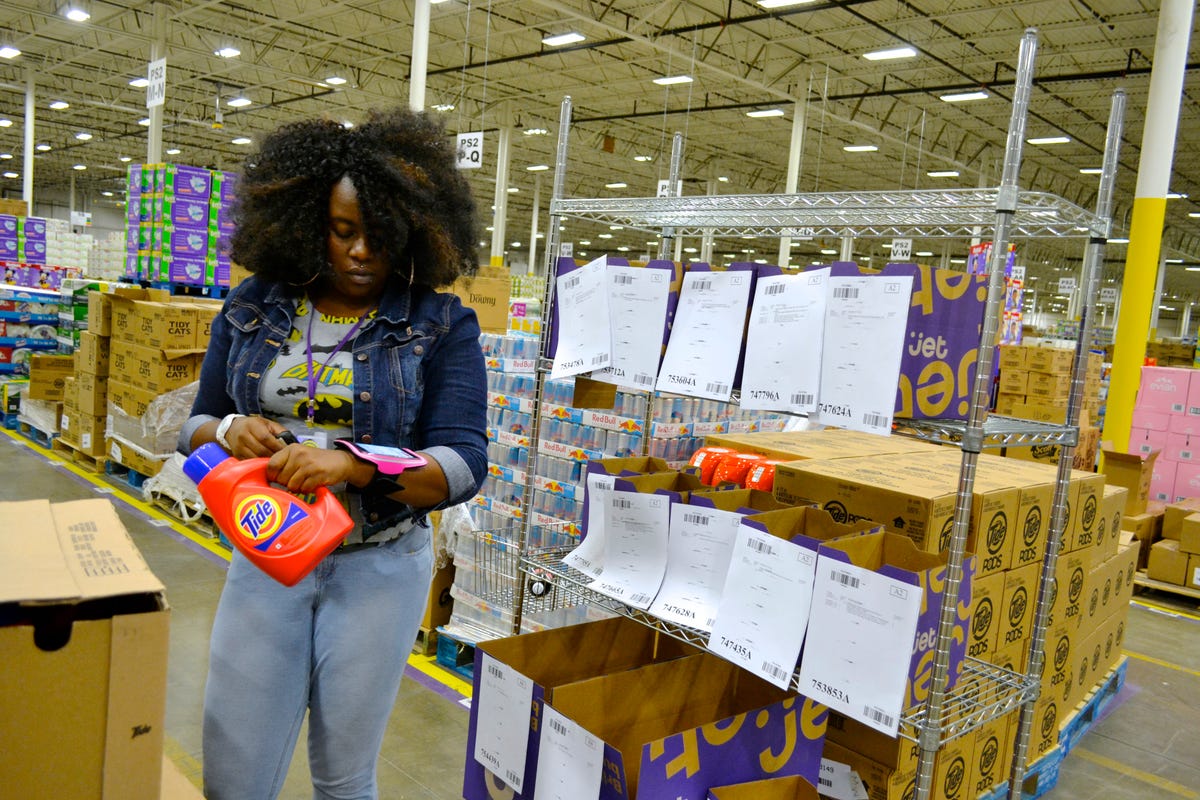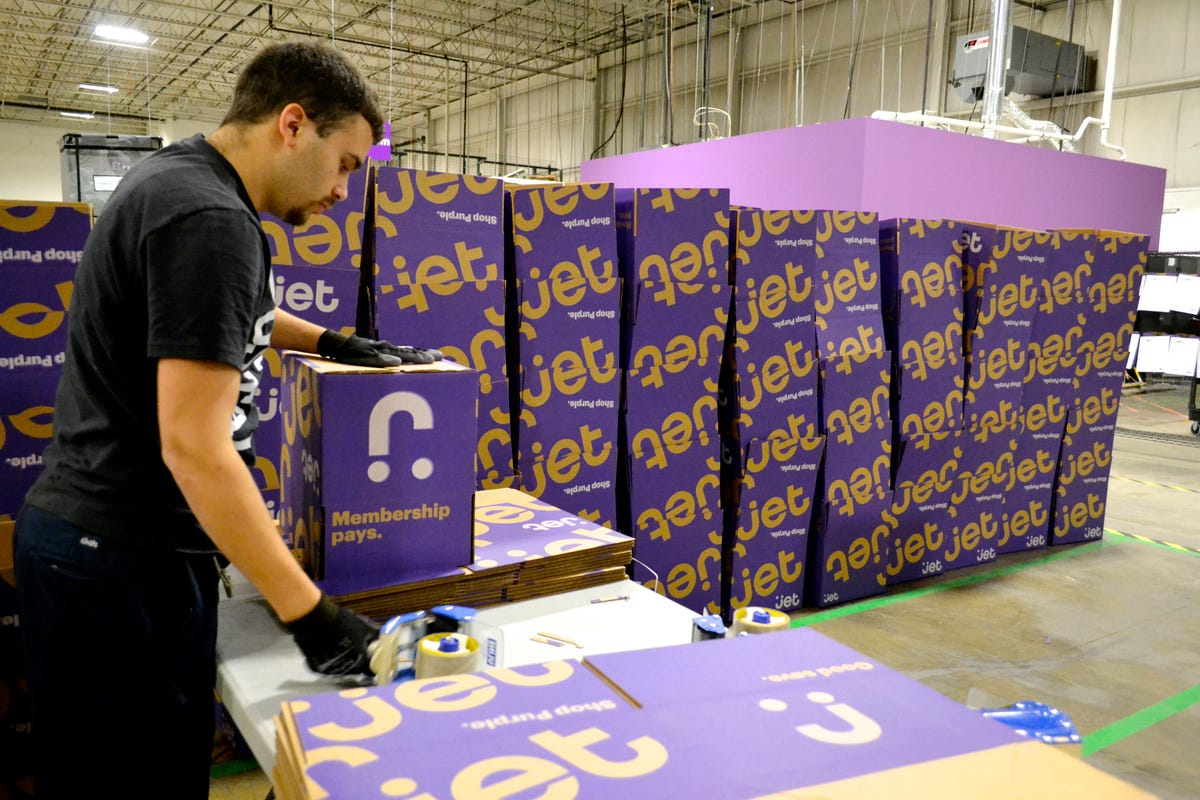As college students, Marc Lore and his childhood friend Lakshman “Lax” Chandra toted a good-luck charm when they bet on horses at the Monmouth Park Racetrack in Oceanport, New Jersey. Their amulet: a laptop computer.
The pair would check which betting pools other spectators were putting their money into and fed that data into software Lore had designed to help them find the most favorable places to wager. The program didn’t guarantee success in each race, but it improved the odds enough that they’d win more often than lose.
“Everything to him can be a math problem,” Chandra said of his friend.
Lore has a new equation to solve. The 44-year-old entrepreneur is betting a love of math will help his startup, Jet.com, take on Amazon, the e-retail giant that bought his last venture for half a billion dollars in 2011. Just as Lore’s program gave him the edge at the track, Jet is powered by software that helps consumers save money when buying everything from paper towels to smartphones. It does this by teasing out the most efficient shipping patterns and enticing customers to place bigger orders.

Co-founder and CEO Marc Lore, at Jet’s new office in Hoboken, New Jersey, has raised more than $700 million toward establishing a major new player in e-commerce.
Ben Fox Rubin/CNET
Investors are banking on Lore’s experience and have filled Jet’s coffers with more than $700 million, a huge sum for such a young company. Jet and its math, they’re betting, will give shoppers more choices and perhaps change the way they buy online.
Lore says the math of the market will do the heavy lifting for his company, which launched over the summer.
“In the next 10 years, $700 billion [in consumer spending] will be coming from offline to online,” Lore says. “So if you can get just 10 percent of what’s coming, the market is massive.”
It’s an open question whether Jet’s fancy software is enough to make it in the cutthroat e-commerce world. Amazon is as tough a competitor as there is. The Seattle e-commerce company aggressively expands and often forgoes profits to undercut other online retailers. The last time Lore went toe-to-toe with the company, Amazon started a price war with Quidsi, Lore’s previous startup and the parent of Diapers.com. It eventually gobbled up his business.
My way
Earlier this month, I visited Jet’s sparkling new office space in Hoboken, New Jersey, which provides an Instagram-ready view of the Hudson River and Manhattan skyline and offers hints of native Frank Sinatra wherever you look.
After a short tour, Lore and I left for a sushi restaurant a few blocks away. He doesn’t like wasting time and energy on small decisions, so he has the same meal — green tea, seaweed salad and salmon sashimi — nearly every day. A creature of habit, he ate at another sushi restaurant every day when he ran Quidsi.
Lore, who previously worked at Credit Suisse and Sanwa Bank, explained why Amazon, his employer for two years after the Quidsi sale, wasn’t going to trounce Jet. He didn’t come off as a numbers geek or an egotistical startup guru. He has a plan, numbers to back it up and energy to carry it out.
“He’s a really unusual combination,” Jet executive Liza Landsman later told me, describing Lore as brilliant and a tad shy. “He makes me laugh, not always on purpose,” she added, noting how Lore will confidently pitch investors for millions of dollars but is sometimes reluctant to ask a stranger to pass the salt.
Jet’s software program, Lore told me, is like a real-time trading platform. It unearths ways to make purchases more efficient. Say you want to buy dog food and a bowl. The software will see if the warehouse can also send you a leash at almost no additional shipping cost. That’s a savings, if you need a leash. And if you’re willing to waive returns, you can save even more.
“We’re basically transparently showing customers how much they can save by shopping in a smarter way,” said Lore, wearing jeans, a checkered shirt and a big-faced Cartier watch.


At Jet’s offices, there’s plenty of the company’s signature purple to go around.
Ben Fox Rubin/CNET
Jet’s strategy of encouraging customers to make fewer but larger orders contrasts with the way many shoppers use Amazon to make lots of single, impulse purchases they expect to receive fast. Lore argues there are hidden fees in shipping lots of items separately and so quickly, and shoppers sometimes foot the bill.
Amazon declined to comment for this story.
One Jet customer, Jeff Meredith, a 52-year-old software developer from Littleton, Colorado, said he’s been using the site just about every week to buy paper products, sauces and snacks. While pleased with his experience, he said he doesn’t know of any friends who use Jet, despite the company’s massive advertising push to draw in customers
“I don’t know if it will [succeed],” he said. “But I’m going to continue using it.”
Another shopper, Elaine James, 23, of Philadelphia, said she bought laundry pods and household cleaners from Jet a few weeks ago but finds it unlikely she’d stop using Amazon.
“There’s just so much that they do that I’ll be a loyal customer,” she said of Amazon and its huge selection of goods.
It had to be you
Lore spent his youth trying all kinds of ways to make a buck: lawn-mowing, lemonade stands, you name it. As kids, he and Chandra spent weeks in Lore’s family basement in New Jersey sorting hundreds of baseball cards to sell as sets. As adults, the two teamed up in 2000 with another childhood friend, Vinit Bharara, to start a baseball card trading platform called The Pit; they sold it to Topps about a year later for $5.6 million.


Warehouse employee Danielle Richardson walks through the aisles of Jet’s new Swedesboro, New Jersey, facility, helping pull together new orders for delivery.
Ben Fox Rubin/CNET
In 2005, Lore and Bharara started Quidsi
Now co-founder and CEO of his third startup, Lore claims his business model for a retail marketplace has been proven to work but needs scale to become sustainable. He’s already raised enough money to stay afloat for the next two years. Now he needs Jet to grow quickly to reach his goal of $20 billion in sales by 2020. That would place Jet in the top echelon of US online retailers, next to Amazon, Apple and eBay.
MORE E-COMMERCE STORIES
- E-commerce startup Jet.com launches
- Amazon gets primed for 2016
- Cyber Monday nabs sales record again
Jet hit $39 million in sales in November, the start of the hectic holiday shopping season, up 18 percent from October. It’s on pace to reach a half billion in annual sales, which is great for a new retailer but still far from Jet’s lofty goal. And Lore doesn’t expect his new company to be profitable for up to five years.
“He’s done this before and he’s a smart guy and he knows Amazon’s playbook,” said Forrester online retail analyst Sucharita Mulpuru. “But he’s signing up for a difficult objective.”
Come fly with me
To get a sense of Lore’s outsized ambition with Jet, I drove down to the company’s new distribution center in Swedesboro, a rural borough deep in South Jersey. The area, ringed by flat farmland, was filled with squat warehousing space for retailer HHGregg, Home Depot and other companies. There was even an Amazon sorting center a short walk from Jet’s building.
Jet’s operations, which opened in late August, took up the majority of its 300,000-square-foot building. Staffing there has ramped up quickly, going from 20 people in July at a smaller facility nearby to 225 now. To reach its massive sales goals, Jet plans to hire over 10,000 by the end of 2020, up from 900 today.
At the warehouse’s outbound station, a group of employees listened to loud pop music as they taped boxes colored in Jet’s eye-catching signature purple. Nearly everything was purple. The walls. The warning lights. Workers even show up wearing purple clothing.
“It just creeps into your wardrobe,” says Joseph Gullo, who runs the Swedesboro center and was wearing a purple sweater.


Jet worker Francisco Roman builds dozens of purple Jet boxes for upcoming orders.
Ben Fox Rubin/CNET
Nearby, supermarket goods, including diapers, cat food, steak sauce, shampoo and candy bars, were loaded on pallets and stacked in aisles. Jet sells consumer staples like these directly from its three warehouses, leaving third-party merchants, including Toys “R” Us and Asics, to sell the rest of the items on the company’s site. Jet now offers about 9 million items. Amazon, by comparison, has inventory that’s estimated in the hundreds of millions.
The best is yet to come
Still, Lore says the math is on Jet’s side. Online shopping in the US is expected to grow nearly 45 percent over the next five years, according to Forrester. With almost half a trillion dollars spent on the Web, Lore reckons there’s room for a few other online players to coexist with Amazon.
“The size of the non-Amazon market is massive,” Lore says, adding Amazon will continue to flourish. “There’s opportunity for not just Jet but multiple players to be super successful.”




